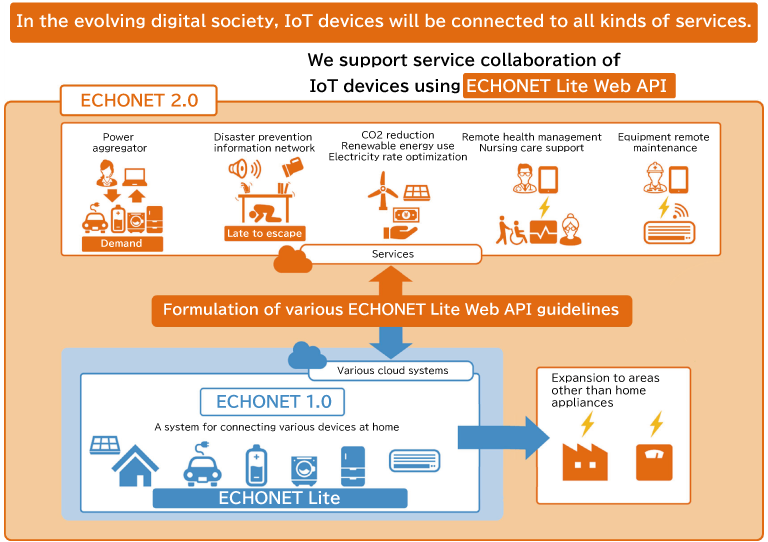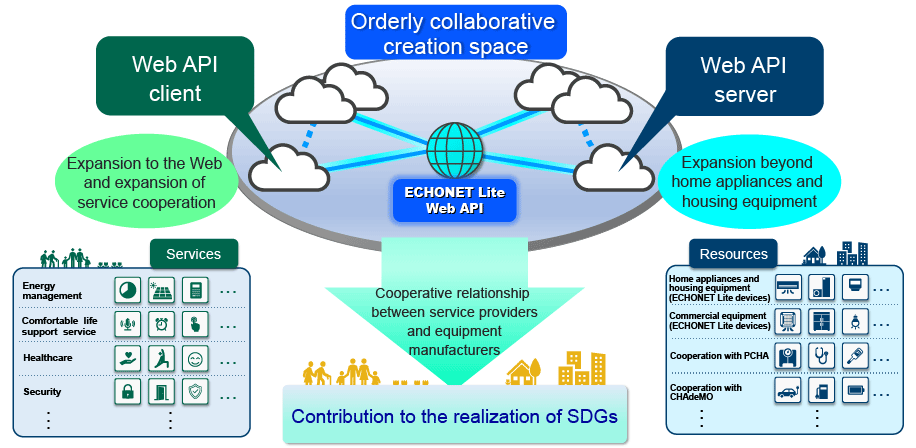The world that ECHONET 2.0 is aiming for
Nowadays, various services are increasing in the virtual space on the cloud, and it has become the age that is aiming to realize a super smart society by Cyber Physical System (CPS). As the Internet environment and society itself change drastically, ECHONET Consortium set up the “ECHONET 2.0 Strategic Guidelines” in February 2022 to contribute to the realization of SDGs, and is strengthening the cooperation with related organizations along with expanding the ECHONET Lite standard and AIF specification. Toward the widespread adoption of ECHONET Lite devices and services that utilize the ECHONET Lite Web API, we will enhance interoperability through the expansion of related standards and certifications and realize an “Orderly collaborative creation space.”
ECHONET 2.0 aims to expand in two directions. The first one is to expand and enrich the ECHONET Lite standards, which has become popular in homes and lifestyles, to fields other than home appliances and housing equipment. The second one is to create and expand new value by expanding service collaboration on the cloud using ECHONET Lite Web APIs, so that various devices in the home can be connected to all kinds of services in the evolving digital society.

“Orderly collaborative creation space” in cyber space
In order to realize service cooperation to create new value, it is necessary to cooperate with services on the cloud, including not only ECHONET Lite devices in the home but also various IoT devices. The ECHONET Consortium realizes this cooperation by providing “ECHONET Lite Web API” and aims for smooth service cooperation in the cyber space. For that reason, the cyber space where cooperation with services is developed must be an “orderly collaborative creation space.”
Specifically, first of all, both the device side and the service side must be reliable businesses, so it is also important to create a mechanism to prove it. It is also necessary to be able to easily confirm the interconnectable interfaces on the cloud. The ECHONET Consortium will tackle such issues in cyber space and contribute to the creation of an orderly collaborative creation space.

Expansion of new service integration by Web API server and Web API client
ECHONET Consortium is also considering the components of an orderly collaborative space in cyberspace.
The figure below shows them, with the “Web API Server” on the right and the “Web API Client” on the left. The Web API server defines the functions that can be provided by modeling the functions of the device in cyber space for a wide range of equipment such as home appliances and housing equipment, as well as commercial equipment, health-related equipment, and electric vehicles, which will be expanded in the future. The Web API client defines services provided to homes, lifestyles and society through cyberspace, such as energy management, comfortable living support, healthcare, and security.
The names of Web API server and Web API client are new names that expect equipment vendors and service providers to play roles that go beyond conventional fields.
By connecting both the ECHONET Lite Web API server and the Web API client via a common interface called Web API in the orderly collaborative creation space, a stronger cooperative relationship will be built and that it will contribute to the realization of SDGs.

Contribution to the realization of SDGs
Through the formulation of the ECHONET Lite standard, ECHONET Consortium has strengthened the creation of an environment in which the interoperability of resource equipment groups can be verified. In the future, in addition to this, we will work to create an environment where we can certify reliable operators and confirm interconnectable cloud interfaces in cyber space and aim to build a cooperative relationship between service providers and equipment manufacturers and contribute to the realization of SDGs.



